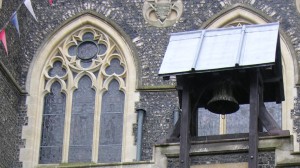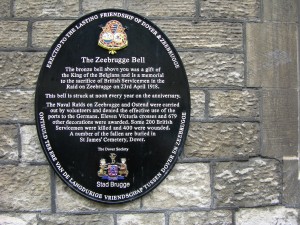The Zeebrugge Bell
St. George’s Day – Zeebrugge Day
A hundred years ago this day…on St. George’s Day (sometimes known as Zeebrugge Day)…23 April 1918, 1,700 British sailors and marines took part in the raid on the port of Zeebrugge, Belgium. Of the 75 vessels used in the attack some are better known than others including HMS Vindictive held against the infamous mile-long Zeebrugge mole by the SS Daffodil, one of two Mersey ferries requisitioned for the raid. Both Daffodil and Iris returned to their traditional roles on the Mersey afterwards but were renamed Royal Daffodil and Royal Iris in honour of their much celebrated participation. All three vessels carried boarding parties.
Another reminder of the raid is located on the Maison Dieu (formerly the Town Hall) High Street, Dover, England where at noon on the anniversary of the Zeebrugge raid a bell, witness to the actions at Zeebrugee, is rung by the town’s Mayor at noon. During the war the bell was taken by German forces from the Belgians and mounted on the mole at Zeebrugge to be rung in the event of an Allied naval or air attack. The Zeebrugee bell was presented, prior to the end of the Great War, by the King of the Belgians to the people of Dover. Initially installed at St. Mary’s Church the bell was re-situated in its present position in 1923. The bell has recently been restored.
The British forces that landed at Zeebrugge suffered many casualties 227 fatalities and 356 wounded. Many awards were granted for gallantry and of the eight Victoria Crosses awarded to service personnel three Victoria Crosses were awarded by ballot; the last occasion on which the Victoria Cross was selected in this fashion. The recipients of the Victoria Cross are as follows:
Major Edward Bamford VC DSO
Royal Marine Light Infantry
Selected by Ballot
For most conspicuous gallantry. This officer landed on the mole from ”Vindictive” with numbers 5, 7 and 8 platoons of the marine storming force, in the face of great difficulties. When on the mole and under heavy fire, he displayed the greatest initiative in the command of his company, and ‘by his total disregard of danger showed a magnificent example to his men. He first established a strong point on the right of the disembarkation, and, when satisfied that that was safe, led an assault on a battery to the left with the utmost coolness and valour. Captain Bamford was selected by the officers of the R.M.A. and R.M.L.I. detachments to receive the Victoria Cross under Rule 13 of the Royal Warrant, dated the 29th January, 1856.
Lieutenant-Commander George Nicholson Bradford VC
HMS Iris II, Royal Navy
Posthumous Award
For most conspicuous gallantry at Zeebrugge on the night of the 22nd-23rd April, 1918. . This officer was in command of the Naval Storming Parties embarked in “Iris II.” When “Iris II.” proceeded alongside the Mole great difficulty was experienced in placing the parapet anchors owing to the motion of the ship. An attempt was made to land by the scaling ladders before the ship was secured. Lieutenant Claude E. K. Hawkings (late “Erin”) managed to get one ladder in position and actually reached the parapet, the ladder being crashed t0 pieces just as he stepped off it. This very gallant young officer was last seen defending himself with his revolver. He was killed on the parapet. Though securing the ship was not part of his duties, Lieut.-Commander Bradford climbed up the derrick, which carried a large parapet anchor and was rigged out over the port side; during this climb the ship was surging up and down and the derrick crashing on the Mole; waiting his opportunity he jumped with the parapet anchor on to the Mole and placed it in position. Immediately after hooking on the parapet anchor Lieut.-Commander Bradford was riddled with bullets from machine guns and fell into the sea between the Mole and the ship. Attempts to recover his body failed. Lieut.-Commander Bradford’s action was one of absolute self-sacrifice; without a moment’s hesitation he went to certain death, recognizing that in such action lay the only possible chance of securing “Iris II” and enabling her storming parties to land.
Captain Alfred Francis Blakeney Carpenter VC
HMS Vindictive, Royal Navy
Selected by Ballot
For most conspicuous gallantry. This officer was in command of “Vindictive.” He set a magnificent example to all those under his command by his calm composure when navigating mined waters, bringing his ship alongside the mole in darkness. When “Vindictive” was within a few yards of the mole the enemy started and maintained a heavy fire from batteries, machine guns and rifles on to the bridge. He showed most conspicuous bravery, and did much to encourage similar behaviour on the part of the crew, supervising the landing from the “Vindictive” on to the mole, and walking round the decks directing operations and encouraging the men in the most dangerous and exposed positions. By his encouragement to those under him, his power of command and personal bearing, he undoubtedly contributed greatly to the success of the operation. Capt. Carpenter was selected by the officers of the “Vindictive,” “Iris II.,” and “Daffodil,” and of the naval assaulting force to receive the Victoria Cross under Rule 13 of the Royal Warrant, dated the 29th January, 1866.
Lieutenant-Commander Percy Thompson Dean VC
HM Motor Launch 282, Royal Naval Volunteer Reserve
For most conspicuous gallantry. Lieutenant Dean handled his boat in a most magnificent and heroic manner when embarking the officers and men from the blockships at Zeebrugge. He followed the blockships in and closed “Intrepid” and “Iphigenia ” under a constant and deadly fire from machine and heavy guns at point blank range, embarking over 100 officers and men. This completed, he was proceeding out of the canal, when he heard that an officer was in the water. He returned, rescued him, and then proceeded, handling his boat throughout as calmly as if engaged in a practice manoeuvre. Three men were shot down at his side whilst he conned his ship. On clearing the entrance to the canal the steering, gear broke down. He manoeuvred his boat by the engines, and avoided complete destruction by steering so close in under the mole that the guns in the batteries could not depress sufficiently to fire on the boat. The whole of this operation was carried out under a constant machine-gun fire at a few yards range.. It was solely due to this officer’s courage and daring that M.L.282 succeeded in saving so many valuable lives.
Sergeant Norman Augustus Finch VC MSM
HMS Vindictive, Royal Marine Light Infantry
Selected by Ballot
For most conspicuous gallantry. Sergeant Finch was second in command of the pompoms and Lewis guns in the foretop of “Vindictive,” under Lieutenant Charles N. B. Rigby, R.M.A. At one period the “Vindictive” was being hit every few seconds, chiefly in the upper works, from which splinters caused many casualties. It was difficult to locate the guns which were doing the most damage, but Lieutenant Rigby, Sergeant Finch and the Marines in the foretop, kept up a continuous fire with pompoms and Lewis guns, changing rapidly from one target to another, and thus keeping the enemy’s fire down to some considerable extent. Unfortunately two heavy shells made direct hits on the foretop, which was completely exposed to enemy concentration of fire. All in the top were killed or disabled except Sergeant Finch, who was, however, severely wounded; nevertheless he showed consummate bravery, remaining in his battered and exposed position. He once more got a Lewis gun into action, and kept up a continuous fire, harassing the enemy on the mole, until the foretop received another direct hit, the remainder of the armament being then completely put out of action. Before the top was destroyed Sergeant Finch had done invaluable work, and by his bravery undoubtedly saved many lives. This very gallant Sergeant of the Royal Marine Artillery was selected by the 4th Battalion of Royal Marines, who were mostly Royal Marine Light Infantry, to receive the Victoria Cross under Rule 13 of the Royal Warrant dated 29th January, 1856.
Lieutenant-Commander Arthur Leyland Harrison VC
HMS Vindictive, Royal Navy
Posthumous Award
For most conspicuous gallantry at Zeebrugge on the night of the 22nd-23rd April, 19181 This officer was in immediate command of the Naval Storming Parties embarked in “Vindictive.” Immediately before coming alongside the Mole Lieut.-Commander Harrison was struck on the head by a fragment of a shell which broke his jaw and knocked him senseless. Recovering consciousness he proceeded on to the Mole and took over command of his party, who were attacking the seaward end of the Mole. The silencing of the guns on the Mole head was of the first importance, and though in a position fully exposed to the enemy’s machine-gun fire Lieut.-Commander Harrison gathered his men together and led them to the attack. He was killed at the head of his men, all of whom were either killed or wounded. Lieut.-Commander Harrison, though already severely wounded and undoubtedly in great pain, displayed indomitable resolution and courage of the highest order in pressing his attack, knowing as he did that any delay in silencing the guns might jeopardize the main object of the expedition, i.e., the blocking of the Zeebrugge-Bruges Canal.
Able Seaman Albert Edward McKenzie VC
HMS Vindictive, Royal Navy
Award Selected by Ballot
For most conspicuous gallantry. This rating belonged to B Company of seaman storming party. On the night of the operation he landed on the mole with his machine-gun in the face of great difficulties and did very good work, using his gun to the utmost advantage. He advanced down the mole with Lieutenant-Commander Harrison, who with most of [his party was killed, and accounted for several of the enemy running from a shelter to la destroyer alongside the mole. This very gallant seaman was severely wounded whilst working his gun in an exposed position. Able Seaman McKenzie was selected by the men of the “Vindictive,” “Iris II,” and “Daffodil'” and of the naval assaulting force to receive the Victoria Cross under Rule 13 of the Royal Warrant dated the 29th January 1856.
Lieutenant Richard Douglas Sandford VC
HM Submarine C3, Royal Navy
For most conspicuous gallantry. This officer was in command of Submarine C.3, and most skillfully placed that vessel in between the piles of the viaduct before lighting his fuse and abandoning her. He eagerly undertook this hazardous enterprise, although, well aware (as were all his crew) that if the means of rescue failed and he or any of his crew were in the water at the moment of the explosion, they would be killed outright by the force of such explosion. Yet Lieutenant Sandford disdained to use the gyro steering, which would have enabled him and his crew to abandon the submarine at a safe distance, and preferred to make sure, as far as was humanly possible, of the accomplishment of his duty.



Comments